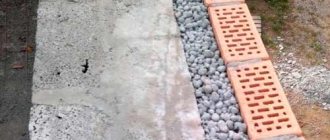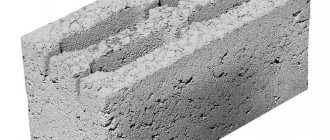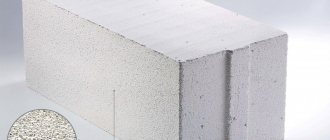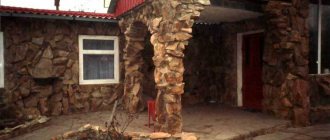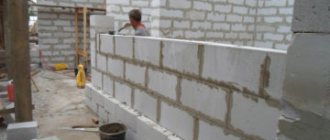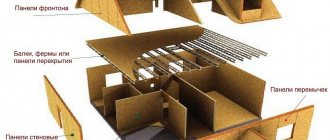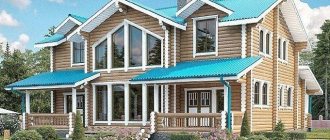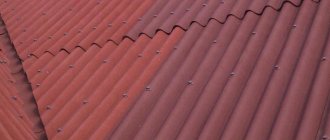No. 1. How to make expanded clay concrete
Expanded clay concrete began to be produced in the middle of the last century, then it was safely forgotten, and today it is experiencing a new era of popularity. The composition of the material, like any lightweight concrete block, includes cement, water and sand , and expanded clay is used as a filler - granules of different sizes obtained by firing low-melting grades of clay. Expanded clay granules are light due to the large number of pores inside, but durable, as they have a strong fired shell. For the production of expanded clay concrete, granules measuring 5-40 mm are used. Blocks can be solid or hollow. Moreover, expanded clay concrete mortar can be used for monolithic construction of house walls .
The ratio of expanded clay and cement has a huge impact on the performance characteristics of the block. The more expanded clay, the lighter, warmer and more expensive the block will be. The quality of cement determines the grade of strength of the material. Due to the expanded clay filler, the material acquires unique thermal insulation properties, for which modern developers love it so much.
Unscrupulous manufacturers add adhesive additives to the mixture to increase the strength of the material, but this has a negative impact on environmental safety. In production, blocks are formed under the influence of vibration and dried in special chambers where they are heated by streams of hot air or infrared rays.
Today, private and country houses, dachas, sheds, garages, fences are built from expanded clay concrete; it is used for monolithic construction of buildings.
No. 2. Expanded clay concrete blocks: pros and cons
The composition of expanded clay concrete determines its many positive aspects, which ensure the popularity of the material. Among the main advantages of expanded clay concrete blocks:
- excellent thermal insulation qualities , which is why the material was chosen by residents of Scandinavian countries. For the harsh climatic conditions of our country, such blocks are irreplaceable. The thermal conductivity coefficient of expanded clay concrete brand D500 is 0.17-0.23 W/m*K, brand D1000 – 0.33-0.41 W/m*K;
- not bad soundproofing;
- low construction cost . The price of expanded clay concrete is comparable to the cost of other lightweight concrete blocks, but significantly lower than the price of brick. If we take into account the reduced costs of arranging the foundation and the smaller number of seams, then we can say that a house made of expanded clay concrete will cost about a third less than a brick house;
- fast construction time , which is associated with the large size of the blocks and their relatively light weight;
- low load on the foundation;
- sufficient strength;
- vapor permeability allows the walls of the house to breathe and removes excess moisture;
- moisture and frost resistance, resistance to fire (the blocks do not melt or burn), mold and rodents;
- durability, which is achieved due to moisture and frost resistance and is at least 75-100 years;
- environmental friendliness, because the composition includes only natural materials;
- no shrinkage;
- the ability to use both traditional mortar and glue for masonry.
Expanded clay concrete blocks also have disadvantages:
- difficulties when working with the material. If many blocks (for example, polystyrene concrete) can be cut with a hacksaw and easily given the required shape, then expanded clay concrete will have to be cut with a saw with pobedit teeth - the other side of strength;
- The complexity of fastening cannot be denied, but this problem should not be overestimated either. For example, anchor bolts and dowels are normally held in expanded clay concrete walls;
- Although the material has vapor permeability, it is less pronounced than that of brick, so it is better to provide high-quality ventilation in the house;
- Another disadvantage is often mentioned - the formation of cold bridges, but it is rather far-fetched, since it absolutely always occurs when walls are built from separate elements. It is possible to get rid of cold bridges if you build walls from expanded clay concrete using monolithic technology;
- if you plan to build a multi-story massive building from expanded clay concrete, then you cannot do without careful professional calculations;
- Another dubious drawback is the need to line the blocks with expanded clay concrete, since they do not look very aesthetically pleasing. Yes, there is little beauty in them, but today almost all houses are decorated, with the only exception being wooden ones. But you can use anything as a finish: siding, plaster with painting, stone, decorative brick.
conclusions
They are obvious. If you compare popular modern building materials and expanded clay concrete, there are pros and cons for each solution.
When choosing, the determining factor may be local prices and individual requirements for the thermal insulation qualities of the walls and the load on the foundation. The video in this article will help you learn more about the features of expanded clay concrete blocks and their use in construction. Good luck!
No. 3. Types of expanded clay concrete blocks by purpose
Expanded clay concrete blocks can be divided into two fundamentally different groups based on the presence or absence of voids:
- full-bodied;
- hollow.
Solid blocks are a structural material with high density and relatively heavy weight. Load-bearing and non-load-bearing walls are erected from it; even multi-storey buildings can be built.
hollow blocks have improved thermal insulation properties and are suitable for the construction of partitions and load-bearing walls of one-story buildings.
Personal opinion
People write reviews about houses made of expanded clay concrete blocks like this.
Nikolay, Chelyabinsk:
- I've been living in this house for three years now. I bought rough blocks, and it took a lot of plaster to put on them. I thought I’d save money, but that’s what happened if I took the front ones. The house is warm and comfortable. I didn't notice any particular shortcomings.
Oleg, St. Petersburg:
- For our climate, this is what we need. We built a small dacha out of them, everything was great. The house is warm, and in the summer, when it’s hot, it’s comfortable even without air conditioning. The downside for me is that when cutting them, I had to buy an expensive, good disc, and that was it. And before that, I wasted about ten ordinary concrete discs.
Sergey, Vorkuta:
- We have a new building, they were built on five floors. My brother lives there. The house is warm even in our severe frosts. I won’t say anything about the finishing, because the apartment was received ready-made, and the external cladding was made from special slabs. An undeniable plus is incredible sound insulation. Even the partitions in the apartment are made of it, and it’s great - you can’t hear your neighbors, and neither can they hear you.
Building your own home is an important matter, so hasty decisions can only harm the process. If the choice is made in favor of expanded clay concrete blocks as the main building material, then all the details and subtleties must be thought out to the smallest detail. Many agree that its disadvantages are insignificant compared to its advantages. Only in this case will the house be warm and comfortable in any weather and in any region of our country.
No. 4. Size of expanded clay concrete blocks
By size, expanded clay concrete blocks are usually divided into:
- wall;
- septal
It is clear that the former are used for laying external walls. They must have certain strength and density indicators, which will be discussed further. In size they can be 288*138*138, 288*288*138, 290*190*188, 390*190*188, 190*190*188, 90*190*188 mm. According to their fullness, they are either full-bodied or hollow.
Partition blocks , as the name suggests, are used for laying internal partitions. They have less weight, which reduces the load on the foundation. In size, as a rule, partition blocks are produced in 590*90*188, 390*90*188, 190*90*188 mm.
Some enterprises produce blocks that do not correspond to the dimensions indicated above - they are made not according to GOST, but according to specifications, which the manufacturer himself can determine for himself. As a rule, large-format blocks are produced according to specifications.
Separately, it is worth noting the facing blocks , which are produced by some enterprises. They have dimensions of 600*300*400 mm, are produced by adding dyes to the solution and have a relief decorative surface.
No. 5. Strength grade of expanded clay concrete blocks
When choosing expanded clay concrete for building a house, garage, partitions, utility rooms and other buildings, it is necessary to take into account a lot of performance indicators of the material: strength, density, frost resistance and thermal conductivity . They are all interconnected. Let's start with strength.
Strength is the ability of a material to withstand loads and resist destruction. Typically, the strength of expanded clay concrete is denoted by the letter M followed by a number from 25 to 100 , which means how many kilograms each cm2 of the block’s surface can withstand. The M25 block can withstand 25 kg/cm2, and the M100 - 100 kg/cm2. In private construction, as a rule, blocks with a strength higher than M100 are not used: M75-M100 blocks are used for the construction of walls, and M35-M50 for partitions. In industrial and multi-storey construction, blocks of greater strength can be used.
It is worth noting that the M75 block can withstand both 65 kg/cm2 and 75 or 80 kg/cm2. Despite the inaccuracies, this method of classifying expanded clay concrete still continues to be used. A much more accurate option is strength classes , which are marked with the letter B. This is strength with guaranteed security. The numerical value is from 2.5 to 40: the higher it is, the more durable the block will be. M100, for example, corresponds to B7.5.
No. 6. Density of expanded clay concrete
Another important indicator is density. The lower the density, the higher the thermal insulation qualities. On the other hand, the higher the density, the higher the strength and resistance to moisture. The density of the blocks is marked with the letter D followed by a coefficient from 350 to 1800 . The coefficient is equal to the density expressed in kg/m3.
The area of use of the material depends on the density:
- structural blocks with a density from D1100 to D1800 have a compressive strength from M100 to M500 and high frost resistance, which allows them to be used for the construction of load-bearing walls that bear significant loads;
- structural and thermal insulation blocks from D600 to D1400 have compressive strength M35-M100, frost resistance F15-F100, ideal for private construction, because they have excellent thermal insulation properties with sufficient strength;
- thermal insulation blocks density D350-D900 with compressive strength M25 can only be used for the construction of partitions and increasing the thermal insulation of load-bearing walls.
What about competitors?
First, let's list the materials with which we will compare expanded clay concrete blocks: disadvantages and advantages.
The list of competing solutions will include:
| Image | Description |
| Red solid brick - fired clay |
| Red hollow brick - the same, but with voids that reduce weight and improve thermal insulation qualities |
| Aerated concrete is a material obtained by adding aluminum powder to a cement-sand mixture, followed by drying in an autoclave at elevated temperatures and humidity. It differs from heavy concrete in its porous structure. |
Expanded clay concrete - solid brick
| Material | Advantages | Flaws |
| Brick |
|
|
| KBB (expanded clay concrete block) |
|
|
Brick walls look impressive without additional external decoration
Expanded clay concrete - hollow brick
| Material | Advantages | Flaws |
| Hollow Brick |
| Low speed of wall construction |
| KBB | High construction speed |
|
Ceramic brick will fit perfectly into the interior design of the house
Expanded clay concrete - aerated concrete
| Material | Advantages | Flaws |
| Aerated concrete blocks |
| Low bending strength compared to KBB. An armored belt, and when constructing two-story or higher houses, an armored frame is required. |
| KBB | Higher compressive and flexural strength | Masonry requires mandatory interior and exterior finishing |
Due to uneven shrinkage of the foundation, the wall made of autoclaved aerated concrete cracked
No. 7. Frost resistance and thermal conductivity of expanded clay concrete
Frost resistance is the ability of a material to withstand sudden changes in temperature. This indicator is determined by the number of shock freezing and defrosting, marked with the letter F. For expanded clay concrete, this indicator can vary from 25 to 300, but in private construction the material F15- F100 . For northern regions, it is better to take material with frost resistance F50-F75. Blocks with low frost resistance are suitable only for interior work.
The thermal conductivity of a material directly depends on density. For the D1000 block it is 0.33-0.41, D1400 - 0.56-0.65, etc. (see table). Depending on which block is chosen for construction and the region in which the house will be located, the thickness of expanded clay concrete is calculated and the need to use insulation is analyzed:
- First, we determine the value of the normalized heat transfer resistance; it can be viewed in the table. Let's say we are dealing with the construction of a house in Moscow, then the desired value is 3.28 m2*K/W;
Standardized heat transfer resistance for Russian cities
- We determine the thermal conductivity coefficient of the building material. Let's say we took D1000 blocks, the average value for them is 0.37 W/m*K, the size is 288*288*138, when laid in one row the wall thickness is 28.8 cm;
- heat transfer resistance of a wall made of expanded clay concrete is 0.288/0.37 = 0.78 m2*K/W, it remains to provide another 3.28-0.78 = 2.5 m2*K/W, for which 10 cm of polystyrene foam with a thermal conductivity coefficient of 0.041 is sufficient W/m*K.
Thermal conductivity coefficients of main wall materials and insulation materials
Laying expanded clay concrete blocks with your own hands
Since the weight of a building made of expanded clay concrete blocks is quite large , it requires the construction of a reliable foundation, and what will be the foundation for a house made of expanded clay concrete blocks largely depends on the geological situation on the site.
It is also necessary to take into account the depth of freezing and the groundwater level, as well as the number of storeys of the house.
For complex, loose or rocky soils, the best choice is a pile-screw foundation.
If the situation on the site is more favorable, then you can choose between two options for a strip foundation: monolithic and prefabricated from foundation blocks (FBS). This option will certainly be chosen by developers who cannot imagine their home without an underground level or basement, an additional room that can have a wide variety of functional purposes.
on how to lay expanded clay concrete blocks with your own hands differ little from the similar procedure used in the construction of houses, for example, from foam concrete. But there are some features and nuances that should definitely be taken into account when working with this material.
Before starting to build a house, it is necessary to waterproof the foundation to protect the blocks from exposure to the damp soil environment.
It is necessary to directly erect the walls in compliance with the dressing rules, which require a mandatory displacement of the next row by at least a third of the length of the block in relation to the previous one. Also, to ensure the rigidity of the structure, the masonry should be reinforced approximately every 3-4 rows - depending on the number of storeys of the house, and, consequently, on the expected load-bearing load.
After each row, it is imperative to check the accuracy of the masonry using a building level and plumb line.
One of the important questions when building a frame at home is what masonry mortar to use for expanded clay concrete blocks. The most common option is a regular cement-sand mortar, but you can also choose cement-based adhesive mixtures, since they allow you to make thinner connecting seams, which partially helps to cope with the problem of the formation of “cold bridges.”
And if a traditional masonry mortar is used, which should be applied in a layer of no more than 12-15 mm, then the correct proportions must be observed in its manufacture, which are determined by the density of the block products used for construction.
If expanded clay concrete blocks are laid in two rows, then they are erected simultaneously, always being tied together to ensure the reliability of the house structure.
After the box of the first floor is ready, it is imperative to make an armored belt on expanded clay concrete blocks, which can be made of brick or in the form of a reinforced concrete monolithic structure, with the preliminary production of formwork for it.
But regardless of the material used, the armored belt must be thermally insulated, since in any case its thermal conductivity coefficient is higher than that of the walls. Similarly, the armored belt, when constructing a building of several floors, is performed after the completion of each of them.
To finish a house made of expanded clay concrete blocks, you can use a variety of materials. One of the popular options is plaster made using the “wet facade” method. In this case, insulation of expanded clay concrete walls can be done using expanded polystyrene or polystyrene foam, as well as materials based on mineral wool.
In addition, a suspended ventilated facade system can be used for finishing using siding as a decorative layer. Facing with brick, or ceramic tiles, artificial cane, clinker, etc. is also allowed.
Opponents of construction from expanded clay concrete blocks hint at the rather high costs associated with finishing the house.
But as evidenced by reviews from home owners , the main advantage of such buildings is a unique microclimate, which can be easily created due to the characteristics of the material, reduced heating and maintenance costs and durability.
No. 8. What to look for when choosing?
A visual inspection can tell a lot about the quality of the material. Pay attention, first of all, to the following points:
- block geometry . It doesn’t hurt to compare several samples and measure their parameters. It will be much easier to build from identical blocks, and the house will turn out to be of higher quality. Uneven blocks are subject to shrinkage and swelling;
- all edges and corners must be smooth and without chips;
- The color of a well-made block is dark gray, like asphalt after rain. Interspersed with white, black colors or the presence of yellowness indicates an excess of sand and a violation of the production technology;
- the surface of the block must be rough;
- The weight of blocks from the same batch should be the same, only a slight deviation is acceptable. Naturally, there should not be any chips on the surface.
Grade
Now the dear reader and I are quite familiar with the material, which allows us to give it a balanced assessment. So, expanded clay concrete blocks: pros and cons.
Delight and adoration
The advantages of expanded clay concrete blocks can be read in any advertising brochure of any manufacturer of this material.
Here is a brief summary of the praises addressed to them:
- Low thermal conductivity , which means significant savings on heating in winter and coolness in the house in summer;
Please note: Yes, the high thermal conductivity of the walls can be compensated for by external insulation of the facade, but this will mean additional costs at the construction stage.
The walls provide high-quality thermal insulation and do not require additional insulation
- High mechanical compressive strength , quite comparable to the strength of solid red brick. For the builder, this means the ability to build a low-rise building without a reinforced frame; for the home owner, it means trouble-free installation of hanging furniture and shelves on the walls;
A house with an attic floor is being built without reinforced belts and reinforced frames
- Large block sizes with precise observance of its dimensions . Therefore, the construction of walls will speed up several times compared to brickwork, and the geometry of the walls will be easier to make perfect;
- Relatively low density means reduced load on the foundation. Expanded clay concrete walls can be erected on shallow strip and even screw foundations;
Inexpensive screw foundation ideal for heaving soils
- When evaluating expanded clay concrete blocks - advantages and disadvantages, do not forget to compare the environmental friendliness of different materials. Expanded clay concrete does not contain polymer or artificial additives in general; it is produced only from natural components (clay, sand and limestone, which is used in the production of Portland cement);
- Finally, a huge advantage of the material is that it can be produced with your own hands . In addition to more than affordable raw materials, production requires only a concrete mixer and a vibration stand costing 10-25 thousand rubles, depending on the size. At current prices for expanded clay, cement and sand, the cost of a cubic meter of finished blocks will decrease with their artisanal production from 3-4 thousand rubles to 1.5-2 thousand.
Vibrating stand with molds for handicraft production of expanded clay concrete blocks
A little fly in the ointment
What disadvantages of expanded clay concrete blocks should be taken into account when choosing a building material:
- Hygroscopicity and moisture permeability. A wall that is not protected by finishing or roof overhangs will absorb rainwater. As a result, its thermal conductivity will increase, and the alternation of dampness with frost will lead to accelerated destruction of the walls by moisture crystallizing in the pores;
Information: expanded clay is one of the most hygroscopic insulation materials. After lying in water, it is able to increase its specific gravity by 3-4 times.
- One can, with some stretch, write down the disadvantages of expanded clay concrete as the unpresentable appearance of the masonry. It requires finishing not only for protection from moisture, but also for aesthetic reasons. Our material also does not fit perfectly into the interior design of a living space;
Expanded clay concrete walls are protected by an insulated ventilation façade
- Due to natural drying, there remains some variation in size between blocks from the same batch. Yes, small - but the masonry will no longer be as ideal as in the case of autoclaved aerated concrete.
Autoclaved aerated concrete allows you to make the masonry absolutely flawless
No. 9. The best manufacturers of expanded clay concrete
Today there are many factories producing such a promising building material, and there is a great risk of stumbling upon a low-quality product produced in inappropriate conditions. A normal manufacturer is not afraid to show the production process and invite the buyer to the factory, and can provide all the necessary quality certificates and test results. Let's look at the largest manufacturers of expanded clay concrete blocks:
- Cheboksary Stroykombinat is one of the largest enterprises in the industry, produces up to 7,500 blocks per day, has passed all the necessary and voluntary certification, personally deals with logistics issues (delivery to almost all regions of the country) and does without intermediaries, which reduces the price of the product. Expanded clay concrete blocks are produced with strength M35-M100, density D1050-D1500, frost resistance F35-F50 and in different sizes, incl. partition and wall, hollow and solid;
- JSC "Keramzit" is an enterprise specializing in the production of a wide range of products based on expanded clay, equipped with its own laboratory and modern equipment. Delivery is carried out in Ryazan and the Ryazan region. Solid, hollow blocks, and blocks with ridges are produced. The plant offers several series of blocks, dividing them according to strength and density, the choice is huge;
- Concrete produces a wide range of building materials, incl. and high-strength expanded clay concrete (M100-M200);
- TPA Unite LLC is an enterprise located in the Moscow region. Production is carried out in compliance with GOST. Expanded clay concrete blocks are the main specialization of the plant. Products of different sizes, hollowness, strength and density are produced here, the quality is high;
- LLC "Keramzit" located in the Tula region, produces blocks of different sizes and with different characteristics, incl. foundation blocks. Production is carried out strictly in accordance with GOST standards.
